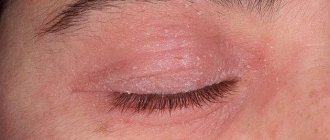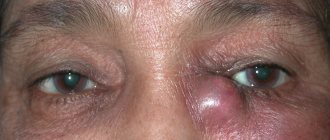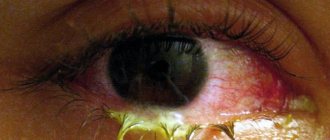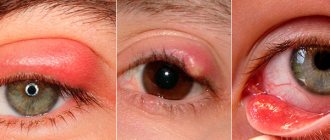Antibiotics are often used to combat conjunctivitis. Caution should be exercised when taking antibacterial drugs. Treatment of conjunctivitis with antibiotics can only be prescribed by a doctor.
In this article
- Symptoms of bacterial conjunctivitis
- Antibiotics for the treatment of conjunctivitis
- Antibiotics drops
- Antibiotic ointments
- Treatment of conjunctivitis with antibiotics in children
- Rules for the use of antibiotics
The use of antibiotics in the treatment of conjunctivitis depends on the nature of the disease. If the cause of eye inflammation is a virus or allergy, then therapy is carried out without taking antibiotics. For allergic and viral conjunctivitis, antibiotics can only do harm. They disrupt the normal microflora of the mucous membrane and worsen the course of the disease.
When treating bacterial conjunctivitis, the use of antibiotics cannot be avoided. They are the main way to combat this disease. Antibacterial agents suppress the growth of bacteria and the development of pathogenic microflora. A type of bacterial conjunctivitis is purulent conjunctivitis. Its characteristic symptom is the discharge of purulent mucus from the eyes.
For purulent conjunctivitis, antibiotics are also used. Antibiotics for conjunctivitis destroy pathogens such as streptococci, gonococci, Klebsiella, staphylococci, Pseudomonas aeruginosa and others.
Symptoms of bacterial conjunctivitis
There are several types of conjunctivitis. Moreover, diseases of different etiologies have similar symptoms. If the purulent type of conjunctivitis reveals itself as corresponding discharge, then the remaining signs of the disease are the same as in other types of pathology.
Inflammation with viral, allergic and bacterial conjunctivitis can be accompanied by swelling, pain and burning in the eyes, profuse lacrimation, and fear of bright light. Conjunctivitis may also present with other symptoms. For example, viral conjunctivitis often occurs as a concomitant pathology with colds and can be manifested by fever. Follicular conjunctivitis is accompanied by the formation of small blisters on the inner lining of the visual organs.
Purulent and viral conjunctivitis are also very similar in external symptoms. But, if profuse purulent discharge appears as a result of inflammation of the eyes, then viral conjunctivitis is most likely excluded. But in advanced forms of the disease, purulent mucus can also be released in cases where the cause of the disease is a virus.
Symptoms
There is a whole range of symptoms for this disease:
- As already described above, the discharge of a watery, sticky liquid of yellow, green or mixed color. Another common symptom that was described earlier is the sensation of a foreign body in the eye.
- Dryness of the eyes and skin, which is caused precisely by this sticky substance. The eyelid is covered with a thin strip that dries to it quite firmly.
- Allergic conjunctivitis is also characterized by damage to the mucous membrane, which is accompanied by nasal discharge. And this is also expressed by difficulty breathing.
- Purulent discharge from the eye.
- Itching and burning of the organ of vision.
- Redness and swelling of the eyes.
Antibiotics for the treatment of conjunctivitis
Before starting treatment, a correct diagnosis is important, since antibiotics are only used for bacterial conjunctivitis. Only a specialist can determine the exact cause of eye inflammation. The use of bactericidal medications for other forms of pathology can only cause harm.
Antibiotics in tablets for conjunctivitis in adults are prescribed extremely rarely. They should be taken when inflammation is caused by rare pathogens. Tablets are selected based on the type of bacteria and the sensitivity of the microorganism to the drug.
A specialist may prescribe antibiotic tablets if conjunctivitis is caused by gonococcus. The inflammation is acute. The disease appears first in one eye, then moves to the second. A characteristic sign is copious discharge of purulent mucus, severe redness of the eyes and swelling of the eyelids. In addition to local medications, antibiotics in tablet form are used in this case. May be assigned:
- "Ofloxacin";
- "Ciprofloxacin";
- "Azithromycin";
- "Doxycycline."
Tablets are prescribed for trachoma. The disease is caused by chlamydia. Its obvious symptom is the formation of follicles on the mucous membrane - small round seals. Trachoma is also characterized by the growth of blood vessels into the cornea and the formation of scars. Antibiotics used:
- "Clarithromycin";
- "Azithromycin";
- "Doxycycline" and others.
The course usually lasts 3-4 weeks. The dosage and regimen of drugs depends on the stage and form of the disease.
Sometimes antibacterial tablets are used to treat other types of bacterial conjunctivitis. Antibiotics for viral inflammation, as already noted, are not used. This is due to the fact that the purpose of these drugs is to destroy bacterial microorganisms; they have no effect on viruses. Antibiotics are also not used for allergic conjunctivitis.
An antibiotic for bacterial conjunctivitis is prescribed by a doctor after examination.
The best antibiotics for conjunctivitis in adults: oral tablets, drops and ointments
Conjunctivitis is an inflammatory pathology of the organs of vision that affects the mucous membrane of the eyes. Most often the disease is caused by a viral infection, other forms are much less common.
Types of conjunctivitis
The conjunctiva protects the eye from damage, penetration of harmful microorganisms, exposure to bright light, and wind. It takes on the blow of unfavorable environmental factors, so it can become inflamed and conjunctivitis develops. A wide variety of etiological factors (fungi, viruses, bacteria, allergens) lead to the appearance of such pathology.
There are several types of conjunctivitis in adults and children, each with its own characteristics:
- Viral. Inflammation develops due to the penetration of foreign agents of a viral nature (adenoviruses, picornaviruses, HSV).
- Reactive. Develops as a result of exposure to environmental irritants (allergens, chemicals).
- Fungal. The conjunctiva becomes inflamed due to exposure to microscopic fungal spores (candida, actinomycetes).
- Bacterial. Its development is provoked by bacteria of streptococcal, gonococcal, and chlamydial nature.
- Parasitic. Inflammation of the conjunctiva is caused by helminths or toxoplasma.
Antibiotics drops
Conjunctivitis of other forms is treated much more effectively with drops and ointments. Local treatment promotes faster recovery than pills.
In the treatment of bacterial conjunctivitis, drops and ointments are the most effective. Today it is not difficult to find antibiotic eye drops in the pharmacy chain. There are many drugs available on the pharmaceutical market. We list the most effective of them:
- "Ofloxacin." It has an effect on most bacterial agents. The drug has age restrictions. It is not prescribed to children under one year of age.
- "Ciprofloxacin." Antibacterial drops with a wide spectrum of bactericidal action. They inhibit the growth of bacteria and lead to their death. They fight most known microorganisms, including enterococci, streptococci, and staphylococci.
- "Lomefloxacin". The active substance is fluoroquinolone - one of the most effective drugs for the treatment of infectious diseases. The product destroys most gram-negative and gram-positive bacteria that cause inflammation of the conjunctiva. Drops are not used in children and adolescents. May cause a burning sensation.
- "Levomycetin". Eye drops based on chloramphenicol, which fights many pathogens. Bacteria become accustomed to the drug slowly. Inexpensive but very effective. The maximum period of use of the drug is 14 days.
- Oftaquix. The main component of eye drops is levofloxacin. The substance effectively fights many pathogens of eye infections. Allowed for children over one year old.
- "Tobrex". A bacterial antibiotic based on the component tobramycin, which has a wide spectrum of action. It has a safe composition, so it can be used in the treatment of newborns and infants.
- "Floxal". One of the most powerful medicines. Kills bacteria that are not affected by other medications. Fights staphylococci, streptococci, E. coli, Klebsiella, enterococci and other microorganisms.
- "Albucid". The product is characterized by high efficiency. The active substance in the drug is sulfacetamide, which inhibits the development of pathogenic bacteria. An additional effect of the product is the rapid elimination of inflammatory processes.
Specific medications are prescribed only by the doctor after examination. Adults should instill drops every four hours.
Please note that eye drops may have side effects, causing itching and burning. Patients may be allergic to some components of the drugs. In this case, the product should be replaced after consultation with an ophthalmologist. When different drugs are used together, their effect is reduced and the risk of adverse reactions increases.
If inflammation is accompanied by purulent discharge, the eyes should be washed with antiseptic solutions.
Kinds
Antibiotics must be prescribed by a doctor for specific indications. The effectiveness of the drug is assessed within 3 days of its use, after which the doctor decides on further therapy or adding additional medications.
The choice of a particular antibiotic depends on the nature of the disease and its severity. To treat bacterial infections in conjunctivitis in adults, medications in the form of tablets, eye drops, ointments, and other forms of antibiotics may be prescribed.
Pills
Antibiotics in the form of tablets for conjunctivitis are prescribed quite rarely, unless the cause of the disease is a rare pathogen. This form of drugs is selected depending on the type of bacteria and their sensitivity to the drug. In addition, tablets for conjunctivitis can be prescribed in the following cases :
- If the causative agent of the disease is gonococcus or chlamydia.
- In acute form of inflammation.
- Copious purulent discharge from the eyes.
- Severe redness and swelling of the eyelids.
- The presence of follicles on the mucous membrane of the eyes.
- Scar formation on the cornea.
- The disease manifests itself first on one eye, then on the second eye.
So, what antibiotics should you take for conjunctivitis? Below is a list of the most commonly prescribed medications in pill form.
| Drug name | Description and Application |
| Tetracycline | This is an effective antibacterial agent that allows you to get rid of gram-positive and gram-negative bacteria, including staphylococcus, streptococcus, chlamydia, mycoplasma and others. The drug is used for conjunctivitis, which is caused by microorganisms sensitive to it. More detailed article about Tetracycline for conjunctivitis |
| Tsiprolet | This is an antibiotic that effectively fights bacteria. It begins to work immediately after entering the bloodstream, so it acts specifically on the cause of inflammation. It cannot be used for viral conjunctivitis and pregnancy. More detailed article about Tsiprolet for conjunctivitis |
| Amoxicillin | Designed to combat various types of microorganisms and has a powerful antibacterial effect. A potent drug of the penicillin group must be taken strictly according to the regimen prescribed by the doctor. Otherwise, there may be adverse reactions that require medical attention. |
| Levomycetin | It has been used in medical practice for quite a long time, therefore it is considered a proven remedy in the fight against infectious diseases, including conjunctivitis. Levomecitin is effective in the fight against gram-negative and gram-positive bacteria that are sensitive to the active components of the drug. In addition, the drug has a low price. |
| Clarithromycin | It is considered a fairly powerful and effective broad-spectrum agent in the fight against infectious diseases. The drug belongs to the group of macrolides, is well absorbed by the body and has a long period of action due to the cumulative effect. |
| Ofloxacin | It has a fairly wide spectrum of action, destroying almost all types of bacterial infections, including chlamydia. Ofloxacin can relieve symptoms of the disease from the first days of use. This drug has a number of contraindications, so it should be used only as prescribed by a doctor. |
| Flemoxin solutab | Almost identical to the drug Amoxicillin and is a powerful antibacterial agent for conjunctivitis. Its use should be consistent with the recommendations of an ophthalmologist. |
Drops
, including eye drops, are considered the most effective treatment for conjunctivitis They can be prescribed only after a thorough examination and in the absence of contraindications for use.
Among the large number of eye drops you can find special drops containing antibiotics. The most effective topical medications are listed below.
| Drug name | Description and Application |
| Dancil | It is considered a fairly powerful antibacterial agent that can suppress bacteria of various groups. The active component of the drug is ofloxacin. |
| Ciprofloxacin | It is a drug of the quinolone group, which is used in the treatment of various forms of bacterial conjunctivitis and is effective in the fight against enterococci, staphylococci and other gram-positive bacteria. The drug is not recommended for use in infants and pregnant women. |
| Lomefloxacin | It is considered a powerful drug in the fight against bacteria that cause inflammation of the conjunctiva. The active component of the drug is fluoroquinolone, which is very effective in the fight against many known gram-positive and gram-negative bacteria. |
| Levomycetin | An amphenicol group drug with a wide spectrum of action. However, its long-term use can lead to the development of adverse reactions, including allergies, circulatory disorders and others. More detailed article about Levomycetin for conjunctivitis |
| Oftaquix | A broad-spectrum antibiotic that belongs to the group of fluoroquinolones. It is effectively used to treat inflammatory processes of the eyes in children and adults, and has virtually no side effects. |
| Tobrex | Belongs to the group of aminoglycosides and has a wide spectrum of action against eye inflammation. This effective drug has virtually no contraindications and is used in various age groups of patients. More detailed article about Tobrex for conjunctivitis |
| Phloxal | Eye drops of the quinolone group, the active ingredient of which is ofloxacin. It is used quite effectively in the treatment of conjunctivitis and other inflammatory processes of the eyes. Despite the gentle effect of the drug, it is contraindicated during pregnancy and lactation. More detailed article about Floxal for conjunctivitis |
| Albucid | Eye drops that are used to treat inflammation and infection of the eyes. The drug is a solution of sulfacetamide with auxiliary components, while having a strong effect in combating the proliferation of bacteria. When using the drug, it is important to follow the dosage to avoid side effects. More detailed article about Albucid for conjunctivitis |
| Azithromycin | One of the most popular and affordable antibiotics for the treatment of conjunctivitis. The drug of the azalide group affects different groups of bacteria, including chlamydia, suppresses their reproduction and slows down their growth. |
| Vigamox | A fluoroquinolone antibacterial drug that is effectively used in the fight against most gram-positive and gram-negative bacteria. Vigamox drops are contraindicated during pregnancy and lactation due to some adverse reactions when used. |
Ointments
Ointments are often used in complex cases of eye diseases, as they are more effective than oral medications.
| Drug name | Description and Application |
| Erythromycin | It is effective against most known bacteria and has virtually no contraindications. |
| Tetracycline | It affects various types of bacteria and is considered a fairly safe and effective antimicrobial agent. More detailed article about Tetracycline ointment for conjunctivitis |
| Eubetal | It contains tetracycline and betamezone, which are very effective in the fight against bacterial pathogens. |
| Colbiocin | It is considered a fairly effective remedy in the fight against conjunctivitis, as it contains potent components - colistin, tetracycline and chloramphenicol. |
| Bivacin | A combined broad-spectrum antibiotic that is active against gram-positive and gram-negative bacteria, including staphylococcus, streptococcus, gonococcus and others. |
Solutions
For any type of conjunctivitis, it is important to properly wash your eyes. Eye solutions should not contain alcohol; most often the base is purified water. Antibacterial solutions are most applicable for purulent discharge from the eyes.
Penicillin
Penicillin and all antibiotics in this group are used in powder form for conjunctivitis, which is used to prepare suspensions for washing the eyes. Such solutions have a wide spectrum of action and are used in the complex treatment of conjunctivitis, which has become acute or complicated.
To cleanse the eye, you need to prepare a solution, moisten a cotton pad in it and wipe the eye in the direction from the nose to the temple.
Expert opinion
Ermolaeva Tatyana Borisovna
Ophthalmologist of the highest category, Candidate of Medical Sciences
These drugs are contraindicated in patients with impaired renal or hepatic function.
Injections
Antibiotics as injections for conjunctivitis are used at the acute stage of the disease or during hospitalization. Depending on the severity of the disease, intraocular or other types of injections may be prescribed.
This treatment is considered the most effective, as it delivers the drug directly to the lesion. Like eye drops, antibiotic injections can cause burning, itching, and discomfort in the eyes.
Antibiotic ointments
The most effective treatment for conjunctivitis will be a combination of eye drops and ointments. The choice of antimicrobial ointments is now also very extensive. Here are the most effective ointments for the treatment of conjunctivitis:
- "Erythromycin". The active ingredient of the ointment is erythromycin. This is one of the most common drugs. The popularity of the product is due to the fact that it practically does not cause allergic reactions. The ointment actively fights listeria, streptococcal, chlamydial, and staphylococcal infections.
- "Tetracycline". The ointment is a broad-spectrum antimicrobial drug. In addition to the active substance tetracycline, the ointment contains several auxiliary components. Refers to safe and effective antibiotics.
- "Eubetal." This ointment contains tetracycline, betamethasone, chloramphenicol, sodium colistimethate. Used to combat bacterial pathogens. At the same time, the ointment relieves swelling, inflammation, and allergic reactions. Not recommended for use by children under 8 years of age.
- "Colbiocin". The product contains three active ingredients: tetracycline, chloramphenicol and colistin. The drug is effective against gonococci, pneumococci, streptococci, chlamydia.
Ointments are an effective remedy in the fight against conjunctivitis. Unlike drops, due to their viscous consistency, they envelop the mucous membrane. The ointment remains in place for a long time, as it is poorly washed off with tears. This prolongs its action.
For complex treatment, the ointment should be applied 15 minutes after applying the drops. As with the use of drops, when treating with ointments, it is forbidden to wear contact lenses.
What to choose: ointment or drops?
It is best if the doctor makes the decision regarding the form of release of the medication. Of course, it is more convenient to use drops, since this process does not take much time. The ointment is more difficult to dose and the process of placing the medicine behind the eyelid is more labor-intensive. However, it is more effective to use ointments to treat conjunctivitis, since they envelop the mucous membrane and remain on the inflamed area longer.
The drops, in turn, are washed out quite quickly along with the tear fluid, so the effectiveness of these antibiotics is not so high. Due to this, it is necessary to instill antibiotics into the eyes much more often, since a sustainable effect is not achieved.
In some cases, specialists prescribe eye drops and ointment at the same time; such measures allow you to quickly get rid of the inflammatory process.
Treatment of conjunctivitis with antibiotics in children
Just like in adults, treatment of bacterial conjunctivitis in children requires antibiotics.
Antibacterial drugs are prescribed to children only when the disease has become protracted. Antibiotics may also be used if the disease cannot be treated with other means. Usually medications are prescribed that contain one or two active ingredients. As a rule, these are drops of “Albucid”, “Eubetal”, “Kolbiotsin”, “Fucitalmic”, “Tetracycline” and “Erythromycin” ointments.
There are no special “children’s” medications. During therapy for young patients, the same drugs are used as for adults. In this case, the dosage is selected very carefully. Ointments, despite their effectiveness, are rarely used in the treatment of conjunctivitis in children. Many of these drugs have age restrictions. Most of them are prohibited for use in the treatment of newborns and infants.
The list of medications is determined only by the doctor. Self-treatment of conjunctivitis is unacceptable.
The most popular medications
Antibacterial drugs can have different release forms. Considering that the conjunctiva is the outer layer of the eye, there is no need to use capsules or tablets. Instead, for conjunctivitis in adults, antibiotics are prescribed as eye drops or ointment. Medicines have a local effect and are practically not absorbed into the blood, which is a definite plus. Next, we will list the most popular and effective medications that are usually prescribed for conjunctivitis.
Rules for the use of antibiotics
The first and most important rule of taking antibiotics concerns the choice of drugs. When antibiotics enter the body, they not only destroy harmful bacteria. Like any chemicals, they affect all systems of the body. Any antibiotic can cause an allergic reaction. Other side effects of these drugs are:
- Gastrointestinal tract disorder. May manifest as stomach pain, nausea, vomiting, diarrhea.
- Toxic reactions. The liver is more susceptible to antibiotics than other organs. While taking antibacterial drugs, toxic hepatitis may develop.
- Weakening of the immune system.
- vitamins Occurs due to a disruption of the natural flora of the colon, which synthesizes some B vitamins.
Therefore, antibiotics can only be taken as prescribed by a doctor. The dosage and regimen should also be prescribed by a doctor. When using antibiotics, you should follow a number of rules:
- antibacterial drops are used during the day, and ointments are applied at night, in this way the greatest effect can be achieved;
- It is forbidden to apply bandages to the eyes, in this case a favorable environment for the growth of bacteria is created;
- It is not recommended to use different drugs topically at the same time. There should be at least 20-30 minutes between doses.
- The medication should not be stopped, even if the symptoms of the disease have disappeared; the course of treatment for conjunctivitis should be completed to the end.
In conclusion, we add once again that the treatment of conjunctivitis begins with a diagnosis. Taking antibiotics before a doctor prescribes them is not allowed. Only a specialist can determine which antibiotic to take.
Rules of application
To achieve maximum effect, medications for adult conjunctivitis must be used correctly:
- drops and ointments with antibiotics are applied only with clean hands, without touching the tip of the bottle to the mucous membrane;
- drops are instilled into the inner corner of the eye, then the eyelid is lightly massaged;
- The ointment is placed in a strip behind the lower eyelid.
The tablets are taken according to the schedule prescribed by the doctor. Since antibiotics change the composition of the intestinal microflora, an adult may experience diarrhea while taking them. To avoid this complication, you must simultaneously drink probiotics - “Linex”, “Hilak-Forte”.
The course of treatment prescribed for an adult or child must be completed in full, even if the symptoms have already disappeared. Interrupted antibiotic treatment contributes to the development of bacterial resistance.
Treatment of conjunctivitis with antibiotics is not always used. In most cases, the doctor prescribes topical medications - drops or ointments. Taking pills is indicated when the disease becomes severe.
Leave comments on the information you read and express your opinion. Share the article with your friends on social networks. All the best.
Antibiotics in adults for conjunctivitis are prescribed in the vast majority of cases. In the presence of such a disease, doctors prescribe complex therapy, which includes these medications. But is their use always necessary and which medications are the most effective? We will look at these questions in more detail in today's article.
Preventive measures
After completing the course of treatment, it is necessary to consolidate the result so that a similar problem does not recur. For this purpose, preventive measures that are aimed at preventing re-inflammation are best suited:
- There should be constant facial care, daily washing and wiping the face - this is an excellent way to carry out prevention.
- Before contacting the eyes (or even just rubbing them), hands should always be clean so as not to introduce a new infection and the inflammatory process does not begin again.
- To wipe your face, you must use only your own individual towel, since various bacteria from other people remain on shared ones (even if your hands and face are washed).
- It is recommended to carry out wet cleaning several times a week to reduce dust in the house, which irritates the mucous membrane of the eye. For a disinfectant effect, various antibacterial agents must be added to the water (for example, bleach if you are not allergic to its smell).
- As a rule, when a foreign body gets into the eye, it is wiped with a handkerchief, but doctors recommend using disposable paper napkins, since bacteria remain on the tissue handkerchief, which can get into the eye and start extraneous inflammation.
- During the allergy season, it is necessary to promptly prevent the occurrence of an allergic reaction. To do this, you need to take antihistamines.
- Before carrying out procedures, it is also necessary to thoroughly wash your hands and use only clean means for carrying them out (napkins, cotton pads, pipettes, etc.).
After the disease has subsided, the patient may experience various disturbances in the visual process, since the mucous membrane of the eye has been damaged. When such problems occur, ophthalmologists strongly recommend the use of topical antibiotics to completely restore the functioning of the mucosa. In addition, medications of this type accelerate healing and restoration of tissue structures with residual inflammation.
It is important to know! The mucous membrane is damaged precisely because of the watery discharge that accompanies the course of the disease.
So, conjunctivitis is a serious disease that can be almost impossible to cope with on your own. For effective treatment without disastrous consequences, you must consult a doctor who, after diagnosis, will prescribe the most appropriate antibiotic treatment. The main danger of the disease is its rich variety and the possibility of re-inflammation due to various factors (this could be an allergic reaction or simply a foreign object getting into the eye, for example, dust). But the main reason for recurrent disease is insufficient hygiene of the face and eye area.











